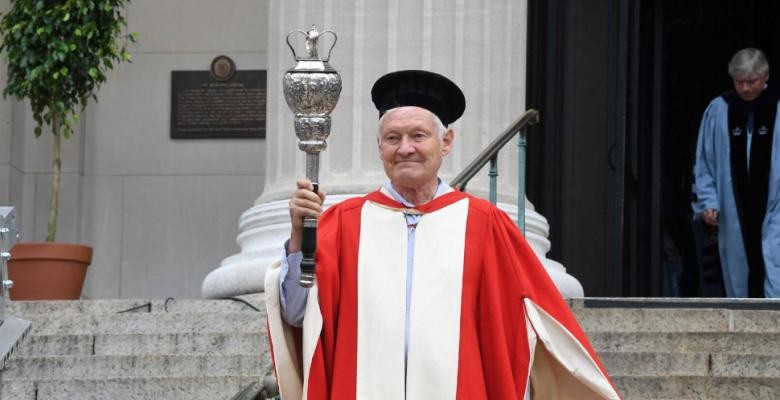Ask Alma’s Owl: Columbia’s ‘Symbol of Office’

Dear Alma,
Why is a mace part of the academic procession at Commencement?
Dear Graduation Observer,
Each year, as the mace bearer descends the steps of Low Library just ahead of President Lee C. Bollinger, the event’s announcer says, “the Columbia mace signifies the University President’s authority to confer degrees on the students of Columbia.”
The first maces, of course, were cudgels used in battle when soldiers wore armor. According to Mary Kemper Gunn in her 1969 book A Guide to Academic Protocol, “from the 16th century in England and since colonial days in America, it has become a symbol of office.”
Many universities have ceremonial maces, including seven of the Ivy League institutions. The eighth, Dartmouth College, has a silver cup that is carried at its commencement. Maces often grace the corridors of political power, including the U.S. House of Representatives, state capitals, the British House of Commons as well as the parliaments in Canada and Australia.
Columbia’s mace was donated in 1933 by John Munro Woolsey (LAW’1901,’29), a federal judge who that same year was best known for his ruling that James Joyce’s Ulysses was not obscene and could be published in the United States. Woolsey was moved to make the donation because the mace had a crown on top, a symbol of the University’s colonial founding as King’s College.
The Columbia mace dates from the 18th century and is a little more than two feet long. Made of Sheffield plate, a layer of silver over copper, it contains a design of acanthus leaves, a symbol of everlasting life, and has an ebony and silver handle. Its usual habitat is in the King’s College Room in Low Library.
The University’s mace bearers wear a colorful red and white robe and a peaked tam instead of their regular academic regalia of Columbia blue, or the colors of the schools from which they received their degrees. Being the mace bearer is considered an honor.
In 2018, it will be carried by Joachim Frank, professor of biochemistry and molecular biophysics and of biological sciences, who shared the 2017 Nobel Prize in Chemistry.
The Lorenzo Da Ponte Professor of Italian, Teodolinda Barolini, (GSAS ’73, ’78) recalls that when she carried it at the 2009 ceremony, “there was a certain amount of effort involved in keeping it high and steady and not letting it wobble,” she said.
George Deodatis, (MS ’84, Ph.D. ’87 ENG) remembers being nervous as he walked with it down the Low Library Steps in 2011. “I was extremely careful to look mostly at the steps rather than the crowd in front of me,” he said. “I was relieved when I reached its resting location.”
Last year, the honor fell to University Professor and Mikati Foundation Professor of Biomedical Engineering and Medical Sciences Gordana Vunjak-Novakovic, who said, “It was a once-in-alifetime experience.”
Send your questions for Alma’s Owl to [email protected].